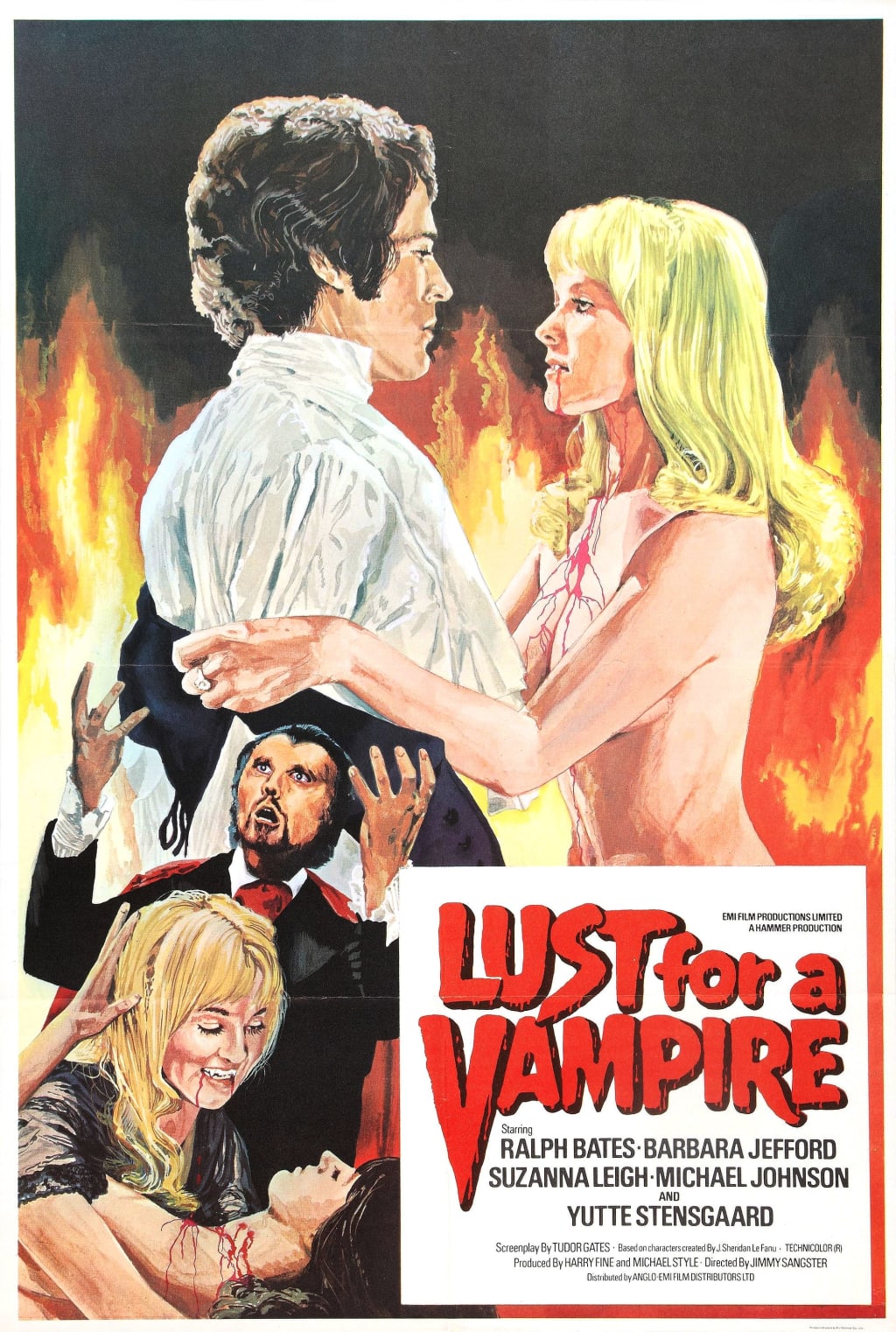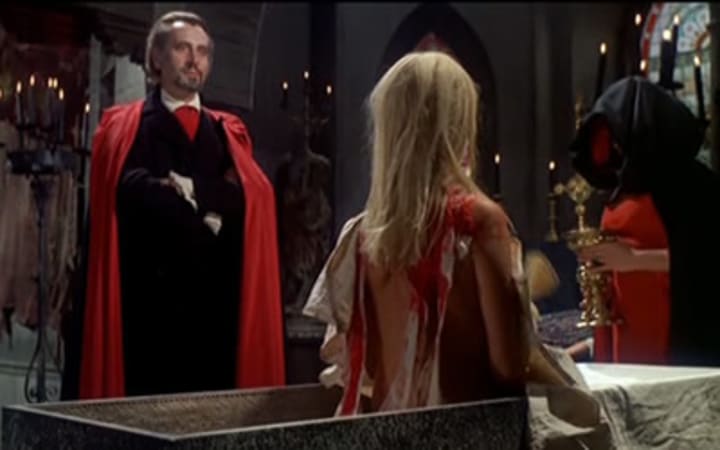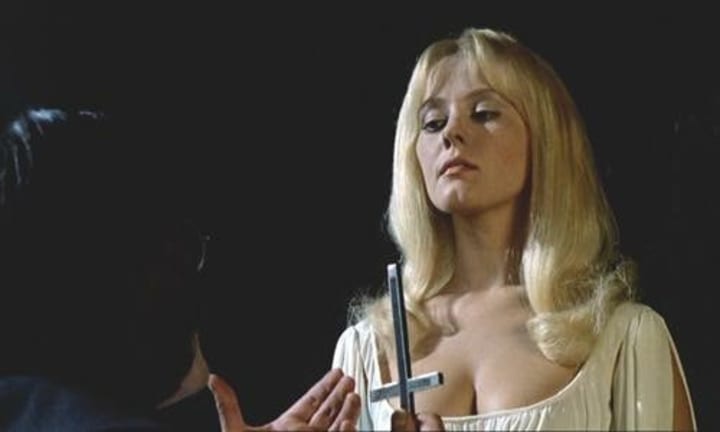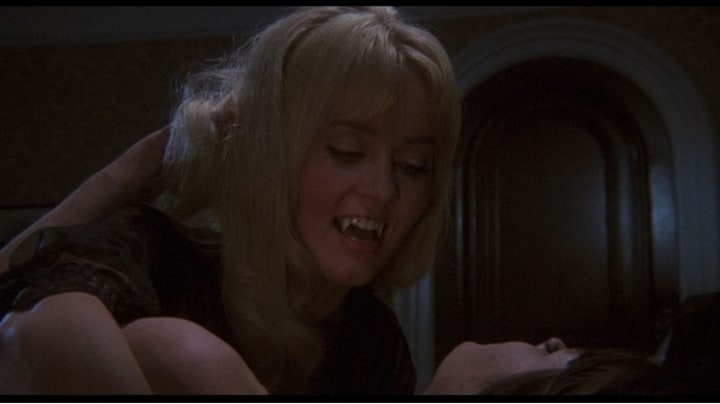Horror Classics: Lust for a Vampire
The second entry in the Karnstein Trilogy Falls Short

In spite of its mixed reception, The Vampire Lovers was successful enough to prompt two sequels. Both were released in 1971 but for now we'll focus on the first of the two - Lust for a Vampire.
Like with the previous entry, there will be spoilers ahead.
The Story
40 years after the last appearance of the Karnstein family, a mysterious man performs a ritual and resurrects Carmilla Karnstein. The vampire temptress subsequently enrolls in a nearby finishing school for girls to feast on the students. Around the same time, an author named Richard LeStrange gets a job at the school and develops an obsession with her.
As one might expect, things go downhill very, very quickly from then on.
Behind the Scenes of Lust for a Vampire
Lust for a Vampire was the second in the Karnstein Trilogy and was released on January 17th of 1971. The film was produced once again by Michael Style and Harry Fine. Tudor Gates returned to write the screenplay and Jimmy Sangster took the role of director.
Now, to say that this film had a troubled production would be an understatement.
The sequel to The Vampire Lovers was planned long before the film was even released with producers lining up a sequel just barely into production on the first one. This, of course, made getting funding for the film difficult. American International Pictures, the company who'd helped fund the previous film refused to help in this case. Hardly surprising when you think about it, The Vampire Lovers hadn't been released and they hadn't seen any of it yet so they weren't sure it would be a success.

Another issue the film faced was the director. Lust for a Vampire was originally meant to be directed by Terence Fisher - a veteran of Hammer Studios so to speak. Unfortunately, he was unable to direct as he was recuperating from a broken leg at the time. This led to Jimmy Sangster taking the reins and things didn't really go too well from here.
The relationship between Sangster and the producers Style and Fine was more than a little strained. Considering that Sangster had a long history of successful films with Hammer (having written the screenplays for both Curse of Frankenstein and Dracula in 1957 and 1958 respectively) this isn't really a surprise. He had almost no creative input on the film and the producers treated him like dirt.
This, of course, had a massive impact on the film as a whole and the rushed production didn't help matters. Regrettably, I wasn't able to find any numbers pertaining to budget and box office so I'm not sure how successful the film was.
General Good Stuff
Well, let's start with general pros.
The music - with one notable exception which I'll get to in a bit - is great. Likewise the locations and cinematography are beautiful. I think Hammer isn't really known for lush countryside shots in their films which is a shame considering the number of fantastic landscapes with which they've captivated audiences over the years.
Setting the film in an all-girls school increases the number of possible victims which is always a plus in a vampire film. It also provides some...interesting potential for the film which was sadly never explored (I'll come back to this.
General Bad Stuff
Let's start off slowly here, the film is slow! It is really, really slow until the last sort of 15 to 20 minutes when the usual angry mob assembles. The tone doesn't have the same sense of dread that the previous film had; instead it's taken a turn for the campy, B-Movie style which is a real shame considering it's predecessor.
Where the last film was dark and tragically romantic, this one seems more interested in displaying as much female skin as possible - not that I'm complaining - than telling a good story.

The characters were largely two-dimensional; with little to no real purpose (other than to be vampire chow). It doesn't really help that the characters who do have personality are largely unlikable - the male 'love interest' in particular has this problem but we'll get to that in a bit!
One song in the film is also a real issue for me. The song is called 'Strange Love' and is played during the only on-screen sex scene. Now, I'm going to come back and talk about that scene in a bit but for now; let's focus on the song. I HATE this song and the worst part is; it's not really the song itself that's the problem! Yes, it's irritating to hear but my issue with the song is more it's presence in the film.
Never mind not being suitable for a sex scene, this song doesn't fit the film at all! It comes out of absolutely nowhere and there's no real reason for it; other than the producers thought it'd be a good idea to add a pop song to the soundtrack. You've spent the bulk of an approximately 90 minute film listening to this great orchestral score and then BOOM! Pop song out of nowhere!
Stand-Out Performances
Returning to the positives for a bit, I thought the performances were...okay. Not great but not necessarily awful. Although, I might be in the minority on this. Actually, considering what the cast had to work with I'm kind of amazed the film was made at all.
With that said, certain performances stood out to me. Before I continue, however, I'd like to reiterate that spoiler warning from earlier; spoilers from here onward.
Mike Raven as the Man in Black (Count Karnstein)

Mike Raven was a popular radio DJ at the time and he was cast as the Man in Black. If you saw my review of The Vampire Lovers you'll know that I had a significant issue with the character of the Man in Black. He had no name, he only appeared a few times and did absolutely nothing when he was on-screen.
I wasn't too keen on seeing him again in a sequel. It's no wonder I was surprised when he started talking, is it? Yes, in this film the Man in Black talks and he actually has something to do! As you've probably guessed, he is the man who performed the resurrection ritual.
Now, he does have stuff to do on screen but it isn't much; he covers up the killings of the students as 'heart attacks' and that's about it. This is a genuine shame, especially when you learn that he's listed as 'Count Karnstein' in the credits.
Considering that he's the head of an apparent vampire family, he could've been way more active than he was. That said, however, Raven's physical appearance and the way he carries himself evokes a sense of discomfort. He's not frightening in the usual sense but you get the feeling that every other character is profoundly disturbed by his very presence.
Barbara Jefford as the Countess Herritzen (Karnstein)

The Countess also returns from the previous film, this time played by Barbara Jefford. Much like with the Man in Black, she has a larger role, also like the Man in Black, her role isn't really that much.
She is billed as Countess Karnstein (Herritzen being her alias) and is, as far as I can tell, supposed to be a vampire as well. Again, she doesn't do anything vampire-y...is that even a word? She's also hardly on screen. So, how come she stands out?
That comes down specifically to Barbara Jefford's performance. Think about the previous film for a minute. The Countess appeared twice for the sole purpose of leaving Carmilla with new victims. Otherwise, she was superfluous. Now, I said Dawn Addams leaves an impression and I stand by that statement but you never get a sense of real connection between her and Ingrid Pitt's characters. There seems to be little to no purpose for Addams' Countess.
On the other hand, Jefford's performance gives us a Countess who is cold and manipulative by nature who does whatever she wants or needs to do without remorse or hesitation.
Yutte Stensgaard as Carmilla Karnstein

Now we come to the main character herself. Ingrid Pitt was intended to reprise her role but she was unavailable - having already been contracted to another Hammer production (Countess Dracula) to be released later in 1971. This was where Yutte Stensgaard came in.
Stensgaard was a Danish model and actress whom I believe had only a few bit-parts in television commercials. She was cast in the role of Carmilla and I'd imagine she was more than a little nervous. Her performance is something a mixed bag. Sometimes it seems like she's trying to emulate Ingrid Pitt's performance in the previous film. Other times she seems to be very unsure of what she's doing.
That said, she's breathtaking on screen and she has a definite presence even if her role feels largely under-developed.
Specific Scenes that Stood Out to Me
The Inspector's Death

An Inspector shows up at the finishing school to reprimand the headmistress for not contacting the police sooner. That's the setup, he chews out Simmons thoroughly before setting off to investigate the campus; eventually discovering the body of one of the girls in the school's dried up well. As he starts to climb out of the well a man in black gloves cuts the rope; he falls back into the well - presumably breaking his neck and dying.
Now, the reason this scene stands out is because of who plays the inspector - Harvey Hall. Hall played a role in all three films in the Karnstein Trilogy. He was Renton (the butler) in the previous film, The Vampire Lovers. He also got arguably the best death in that film; dying as Carmilla lures him into an apparent tryst before sinking her fangs into him. Here he just falls into a well.
Let's face it: death by vampire bite is much cooler.
The Resurrection Sequence

The resurrection sequence stands out mostly due to the ad-libbed dialogue courtesy of Mike Raven. Raven, as previously mentioned, was a radio DJ who had a keen interest in the occult. Apparently he had a large assortment of occult-related books from which he added bits and pieces to the incantation used to resurrect Carmilla.
The added dialogue lends the ceremony some realism points while the spooky atmosphere and visuals put viewers on the edge of their seats.
Overall the entire opening ritual is a very strong jumping-off point. It's sort of a pity that the film couldn't really keep up.
Giles Barton's Death

Giles Barton's death is another scene that stands out to me as it's one of Yutte Stensgaard's more effective scenes. Barton and Carmilla meet in Karnstein Castle's graveyard and the teacher reveals that he knows who and what she is. From there he starts to plead with her to make him a servant - I'm throwing out a guess here because I don't know if he wants to be a vampire himself or serve Carmilla as a human.
Either way, Carmilla just stands there. She says nothing, just smiles and feeds on Barton before walking away and leaving him to die - ignoring his pleas. This is one of Stensgaard's more effective scenes as she acts entirely through facial expression. It's probably the only scene where she seems genuinely threatening.
The Graveyard Sex Scene

Okay, okay, laugh it up and get your minds out of the gutters! Yes, the sex scene stands out in this film - for a few reasons. Let's get the obvious ones out of the way:
- Yutte Stensgaard is gorgeous.
- The location is unusual...obviously.
What makes this seen stand out? Well, the answer is two-fold; setup and execution. Throughout the film Richard leStrange is absolutely obsessed with Carmilla. When Giles Barton is found dead, the horror writer takes a look at the former teacher's research on the Karnstein family before arranging a meeting with Carmilla.
They meet late at night in the graveyard after a brief back and forth, we get this lovely exchange:
leStrange: "I've seen Giles' researches, and believe me; they are powerful evidence."
Carmilla: "Evidence? Of what?"
leStrange: "That you are a vampire."
Carmilla: "You say that, and tell me you love me?"
leStrange: "Prove to me that you're not...love me."
There's your setup. That's right ladies and gentlemen, the man we're supposed to be cheering on; is blackmailing a student into having sex with him...how is this guy our protagonist? I've got more to say about leStrange in a bit but let's finish up with this scene first, shall we?
Execution-wise, once that last line is spoken they have sex and practically the whole scene is comprised of Carmilla's reactions. We see very little of leStrange in this scene and most of what he's doing is hinted at, as opposed to shown outright. This is something we don't see very often in horror films - especially nowadays with how relaxed the restrictions have gotten.
Now, like I mentioned earlier; this scene also contains the one song that should never have been included in the film. The song, Strange Love, was included without the director or screenwriter's knowledge. They only found out about it when the film released to theaters in 1971. I can imagine both wanted to crawl out of their chairs and let the theater floor swallow them.
This Film's Biggest Problem

I talked about how the characters are largely unlikable but let's really get into that aspect now. To start, there's nothing wrong with having an 'unlikable' character or an unlikable protagonist. This is usually because as the story progresses we see what happened to make the protagonist the way he is and by the end he changes and becomes likable - or at least bearable.
That NEVER happens with Richard leStrange! He's unlikable from the first scene right to the end! From the very second he sets eyes on the school, he tries to get a job as an English professor and is turned down. He then meets Carmilla and things get worse. He cons his way into the position of the English professor (whom he presumably assaulted and whose leg ended up broken) and begins trying to pursue Carmilla romantically.
I wouldn't usually have a problem with a romantic sub-plot but this isn't romantic in the least. The relationship between leStrange and Carmilla isn't love. If I had to call it anything, I'd call it lust - at least on leStrange's side. Carmilla does seem to genuinely care for him but he comes across as manipulative, controlling, just all around creepy!
Adding insult to injury, when Carmilla does meet her inevitable end at the climax of the film; he hooks up with the only female teacher at the school - Janet Playfair. This isn't a problem when the characters have good chemistry but these two characters don't interact more than once or twice throughout the film's entire runtime! There's no on-screen chemistry to really speak of and, as previously noted, leStrange is a creep.
Final Thoughts: A Film with Merit

A common complaint that is voiced related to this film and its sequel - Twins of Evil - is that the producers toned down the lesbianism aspect of the Carmilla character. This is something that's a bit of a double-edged sword. On one hand, the bi-sexuality of the character makes sense. On the other hand, it does feel like a betrayal of the character.
You can't really make the argument that she was, sort of, bi-sexual in the previous film. Yes, in The Vampire Lovers, Carmilla seduces Renton (the butler) BUT it's with the express purpose of getting to Emma - her actual target. Having her fall in love with a man kind of changes the dynamic of the character and, as one other reviewer noted, implied that Carmilla was sick and just needed to sleep with leStrange to be cured.
The minimal gore is good and the practical effects work is impressive. Sadly, the film misses out on a lot of potential.
Potential Story
Why not have Carmilla hunt the students and faculty of the school more extensively? She starts out slowly, hunting one or two students and slowly seduces and kills several more while seducing leStrange. In the end, the angry mob forms but instead of Carmilla; they go after leStrange as she's pinned him as the killer.
Maybe she vanishes herself and the few students who've survived blame everything on leStrange - who's been driven mad - and the author is carted off to prison. The Karnsteins vanish again into the night and lie low fading once again into myth and legend before re-surfacing.
Worth Watching?
So, is this film worth watching? Well, I guess so. Ultimately, Lust for a Vampire is...okay. It's extremely dated which is understandable but it does hold up reasonably well to modern film standards in some places (practical special effects). Unfortunately, the weak script and unlikable main protagonist will probably put some people off.
In the end the second entry in the Karnstein Trilogy is just a bland, slow vampire flick that lacks a strong enough bite to hold your attention. All that said, this film is something that fans of classic horror might get a kick out of so I do recommend checking it out and drawing your own conclusions.
So, that's the second entry into the Horror Classics series - next time we'll be looking at the third and final entry in the Karnstein Trilogy: Twins of Evil. I'll see you all there!
About the Creator
Greg Seebregts
I'm a South African writer, blogger and English tutor; I've published 1 novel and am working on publishing a 2nd. I also write reviews on whatever interests me. I have a YouTube Channel as well where I review books, and manga and so on.






Comments (1)
Exceptionally well written review!